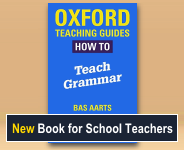National Curriculum KS2 Y3 & Y4: Vocabulary, Grammar and Punctuation
Statutory requirements
Pupils should be taught to:
- develop their understanding of the concepts set out in English Appendix 2 [see the table below on this page] by:
- extending the range of sentences with more than one clause by using a wider range of conjunctions, including when, if, because, although
- using the present perfect form of verbs in contrast to the past tense
- choosing nouns or pronouns appropriately for clarity and cohesion and to avoid repetition
- using conjunctions, adverbs and prepositions to express time and cause
- using fronted adverbials
- learning the grammar for years 3 and 4 in English Appendix 2 [see the table below on this page]
- indicate grammatical and other features by:
- using commas after fronted adverbials
- indicating possession by using the possessive apostrophe with plural nouns
- using and punctuating direct speech
- use and understand the grammatical terminology in English Appendix 2 [see the table below on this page] accurately and appropriately when discussing their writing and reading.
| Y3: Detail of content to be introduced | |
|---|---|
| Word |
Formation of nouns using a range of prefixes [for example super–, anti–, auto–]. Use of the forms a or an according to whether the next word begins with a consonant or a vowel [for example, a rock, an open box]. Word families based on common words, showing how words are related in form and meaning [for example, solve, solution, solver, dissolve, insoluble]. |
| Sentence | Expressing time, place and cause using conjunctions [for example, when, before, after, while, so, because], adverbs [for example, then, next, soon, therefore], or prepositions [for example, before, after, during, in, because of]. |
| Text |
Introduction to paragraphs as a way to group related material. Headings and sub-headings to aid presentation. Use of the present perfect form of verbs instead of the simple past [for example, He has gone out to play contrasted with He went out to play]. |
| Punctuation | Introduction to inverted commas to punctuate direct speech. |
| Terminology for pupils | preposition, conjunction, word family, prefix, clause, subordinate clause, direct speech, consonant, consonant letter, vowel, vowel letter, inverted commas (or ‘speech marks’). |
| Y4: Detail of content to be introduced | |
|---|---|
| Word |
The grammatical difference between plural and possessive –s. Standard English forms for verb inflections instead of local spoken forms [for example, we were instead of we was, or I did instead of I done]. |
| Sentence |
Noun phrases expanded by the addition of modifying adjectives, nouns and preposition phrases (e.g. the teacher expanded to: the strict maths teacher with curly hair). Fronted adverbials [for example, Later that day, I heard the bad news.] |
| Text |
Use of paragraphs to organise ideas around a theme. Appropriate choice of pronoun or noun within and across sentences to aid cohesion and avoid repetition. |
| Punctuation |
Use of inverted commas and other punctuation to indicate direct speech [for example, a comma after the reporting clause; end punctuation within inverted commas: The conductor shouted, “Sit down!”]. Apostrophes to mark plural possession [for example, the girl’s name, the girls’ names]. Use of commas after fronted adverbials. |
| Terminology for pupils | determiner, pronoun, possessive pronoun, adverbial. |
Notes and guidance (non-statutory)
Grammar should be taught explicitly: pupils should be taught the terminology and concepts set out in English Appendix 2 [see the table above on this page], and be able to apply them correctly to examples of real language, such as their own writing or books that they have read.
At this stage, pupils should start to learn about some of the differences between Standard English and non-Standard English and begin to apply what they have learnt [for example, in writing dialogue for characters].
Welcome!

Englicious is totally free for everyone to use!
But in exchange, we ask that you register for an account on our site.
If you’ve already registered, you can log in straight away.
Since this is your first visit today, you can see this page by clicking the button below.
- Printer-friendly version
- Log in to view or leave comments

